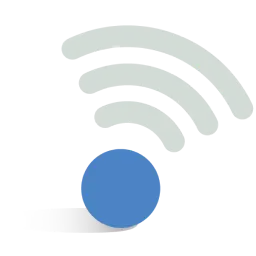from Aston Bay Holdings Ltd (NASDAQ:ATBHF)
Aston Bay and American West Metals Announce Major Copper Discovery at the Storm Copper Project, Canada
- Diamond drilling of a large gravity target has intersected thick intervals of copper sulfides
- The discovery drill holes show similarities to many of the world's major sediment-hosted copper systems, including the deposits of the Kalahari Copper Belt and Central African Copper Belt
- Total of 45.5m of visual sulfides intersected in drill hole ST23-01 comprising:
- 30.5m of breccia-style visual copper sulfide (dominantly chalcocite) within three zones associated with the shallow copper mineralization of the 4100N Zone between 45m and 86m downhole, and deeper in the same hole,
- 15m of visual breccia and vein-style copper sulfide (dominantly chalcopyrite) between 332m and 347m downhole - the first discovery intersection
- Diamond drill hole ST23-02 has intersected a second and more impressive discovery zone:
- 37m of visual breccia-style copper sulfide (dominantly chalcocite with minor native copper) between 333m and 370m downhole
- The two diamond drill holes are located 680m apart - the continuity of the mineralized horizon and the size of the gravity anomaly (>5km long and up to 1km wide) suggests that drilling has potentially identified a large copper deposit
- Mineralization was intersected in both holes at the top of a modeled gravity anomaly, highlighting the potential effectiveness of the technique for exploration targeting
- Gravity targets similar to that intersected by these initial diamond drill holes cover an extensive area at Storm and remain untested by drilling, supporting the potential for a major, regional-scale copper system
- Diamond drilling continues on high-priority copper targets with first assays expected in the next 4 weeks
- Reverse circulation resource definition drilling is also underway on near-surface copper targets with results from the 2750N and 2200N Zones expected shortly
TORONTO, ON / ACCESSWIRE / August 2, 2023 / Aston Bay Holdings Ltd. (TSXV:BAY)(OTCQB:ATBHF) ("Aston Bay" or the "Company") reports significant copper sulfide mineralization intercepts from the initial two diamond drill holes testing a blind gravity target at the Storm Copper Project ("Storm" or the "Project") on Somerset Island, Nunavut, Canada. The program, still underway, is being conducted by American West Metals Limited ("American West"), who are the project operator since entering an option agreement with Aston Bay in March 2021.
"Discovery of sedimentary hosted copper has been the true goal for all explorers at Storm, including Aston Bay. I'm delighted to report that, finally, the quest has succeeded, and we have definitive proof of a new sediment hosted copper system," stated Thomas Ullrich, CEO of Aston Bay. "Our geological model has predicted the presence of chalcocite in permeable sedimentary horizons, hidden in the subsurface - this discovery proves it. The copper is there. Not only have we hit a significant mineralized interval, but presence of chalcocite in the latest hole provides a vector to more copper-rich mineralization within this very large gravity anomaly.
"Both initial drill holes have intersected higher-density copper sulfide mineralization at the top of the modeled density anomaly, and at the same stratigraphic horizon. This confirms the presence of hidden sediment hosted copper mineralization as predicted and, importantly, demonstrates that we have a potentially effective targeting tool to find it: the ground gravity surveys yield excellent resolution and depth control, proven with success at the drill bit.
"Airborne and ground gravity surveys have revealed anomalies, both blind and those associated with surface copper mineralization, for over 10km to the west and south of this discovery. This offers tremendous potential for additional discovery. This discovery is analogous to the world-famous copper belts in Africa that contain some of the world's largest and highest grade copper deposits."
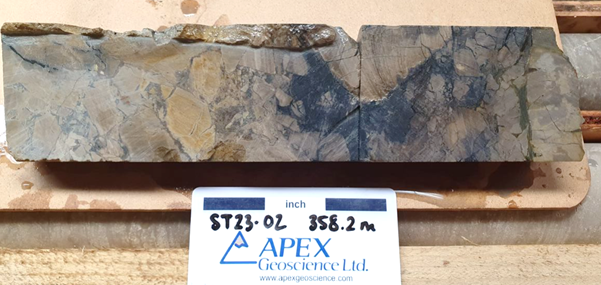
Figure 1: Photo showing example of strong chalcocite (dark grey) breccia fill and veining in drill hole ST23-02 from approximately 358.2m downhole. Chalcocite is a copper sulfide mineral and contains approximately 79.8% copper.
DIAMOND DRILLING HITS THICK AND EXTENSIVE COPPER SYSTEM
Diamond drill holes ST23-01 and ST23-02 have been completed at the Storm Project with both holes intersecting thick intervals of visual copper sulfides. The drill holes were designed to test the outstanding gravity targets that were defined beneath the near-surface mineralization at Storm (see June 9, 2023 Aston Bay news release).
ST23-01 and ST23-02 were completed in key locations below, and to the west of the near-surface, high-grade copper 4100N Zone (Figures 2 and 3). The drill holes have intersected 15m and 37m of visual copper sulfides (respectively) within what is interpreted to be the same mineralized deeper stratigraphic horizon. The copper mineralization consists of chalcocite, chalcopyrite and native copper and is hosted within a vuggy, organic-rich sequence that has a higher density than the surrounding stratigraphy and is interpreted to be the source of the gravity anomaly. This is the first intersection of the higher-copper content mineral chalcocite (79.8% copper) at this stratigraphic depth. Chalcocite is typical in sediment hosted copper deposits, including the deposits of the Kalahari Copper Belt and Central African Copper Belt, and is an important and high-value copper mineral.
Drill hole ST23-01 was also designed to test the northern margin of the copper mineralization within the 4100N Zone. Intersected a total of 30.5m of breccia and vein-style visual copper sulfides within three distinct zones. The sulfides are very similar to the known high-grade mineralization at the 4100N Zone and it remains open to the north.
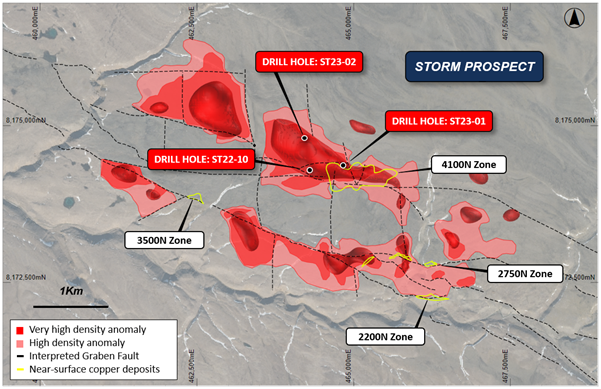
Figure 2: Plan view of the Storm area showing the gravity data interpretation, near-surface mineralization footprint (yellow), major faults, and diamond drill hole locations in this report.
The distinctive mineralized horizon encountered at depth within ST23-01 and ST23-02 is interpreted to correlate with the stronger copper mineralization intersected in 2022 drill hole ST22-10. The holes are located approximately 680m apart and approximately 500m to the north of ST22-10. The large spacing between these drill holes, and scale of the gravity anomalies are strong evidence of a very large, laterally extensive copper system in the Storm Project area.
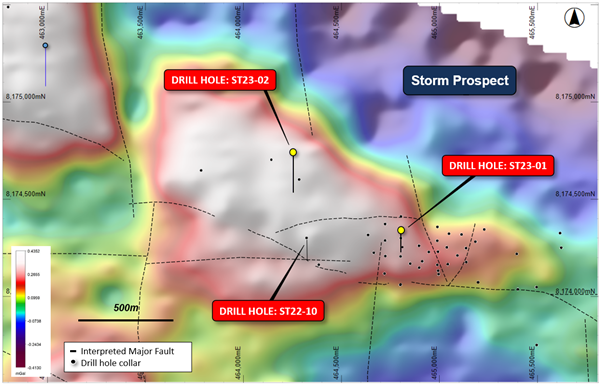
Figure 3: Total bouguer gravity image of the 4100N area, fault architecture and drill hole locations.
Hole ID | Prospect | Easting | Northing | Depth (m) | Azimuth | Inclination |
ST23-01 | 4100N | 464805 | 8174335 | 416 | 180 | -75 |
ST23-02 | EXPL. | 464255 | 8174741 | 602 | 180 | -70 |
Table 1: 2023 diamond drilling program details.
Visual estimates of mineral abundance should never be considered a proxy or substitute for laboratory analyses where concentrations or grades are the factors of principal economic interest. Laboratory assays are required to determine the presence and grade of any contained mineralization within the reported visual intersections of copper sulfides. Portable XRF is used as an aid in the determination of mineral type and abundance during the geological logging process.
DRILL HOLE ST23-01 DETAILS
ST23-01 was drilled to a downhole depth of 416m and intersected two main zones of visual copper mineralization (Figure 7). The drill hole was designed to test the northern extent of the high-grade 4100N Zone, and to test the large gravity anomaly at depth, below the near-surface copper mineralization.
The first zone of copper mineralization encountered within ST23-01 is located near-surface within the 4100N Zone and consists of 30.5m of breccia and fracture-hosted chalcocite and minor chalcopyrite (Figure 10) over three major intervals from 45m downhole. This mineralization is typical of the near-surface copper mineralization at the 4100N Zone and indicates that the mineralization remains open to the north.
A second zone of mineralization was intersected at 332m downhole. The mineralized interval is 15m thick and consists of mosaic breccia and replacement-style chalcopyrite cement (Figure 4). Minor sphalerite (zinc sulfide) is present within the lower part of the sequence.
The sulfides are hosted within a sequence of organic-rich and vuggy dolomudstone. The mineralized zone has a higher specific gravity than the host stratigraphy, which indicates that the drill hole has likely intersected the interpreted source of gravity anomalism.
The mineralization and stratigraphy within the deeper intercept in ST23-01 are visually very similar but contains more chaclcopyrite than the mineralization encountered within drill hole ST22-10 (see September 28, 2022 Aston Bay news release). Drill hole ST22-10 is located 500m southwest from ST23-01 and indicates that the stratigraphy is laterally extensive.
Hole ID | From (m) | To (m) | Min | Description |
ST23-01 | 0.0 | 45 | Cape Storm Formation | |
45 | 58 | cc, cp, py | 4100N Zone - veinlets (1%) | |
58 | 59 | cc, cp, py | 4100N Zone - breccia cement (2-5%) | |
59 | 68 | cc | 4100N Zone - (1.2%) | |
68 | 75.5 | Dolomudstone | ||
75.5 | 78 | cc | 4100N Zone - veinlets of cc throughout (1-2%) | |
78 | 81 | Dolomudstone | ||
81 | 86 | cc | 4100N Zone - veinlets and breccia (2-5%) | |
86 | 100 | Dolomudstone with occasional floatstone | ||
100 | 101 | ml, cc | Localized breccia with cc, ml cement (0.1%) | |
101 | 299 | Dolomudstone, some cherty units | ||
299 | 300 | Doloboundstone with stromatoporoid | ||
300 | 322 | Dolofloatstone with coral and stromatoporoid | ||
322 | 344 | cp | Dolomudstone with chalcopyrite veins/vugs (1%) | |
344 | 347 | cp, sph | Organic rich with mosaic breccia cp (1%) | |
347 | 359 | Bioturbated and fractured dolomudstone | ||
359 | 416 | Dolomudstone with occasional floatstone |
Table 2: Summary geological log for drill hole ST23-01. Mineralization key: cc = chalcocite, cp = chalcopyrite, br = bornite, py = pyrite, Cu = native copper, ct = cuprite, ml = malachite, sph = sphalerite, ga = galena. (5%) = visual estimation of sulfide content.
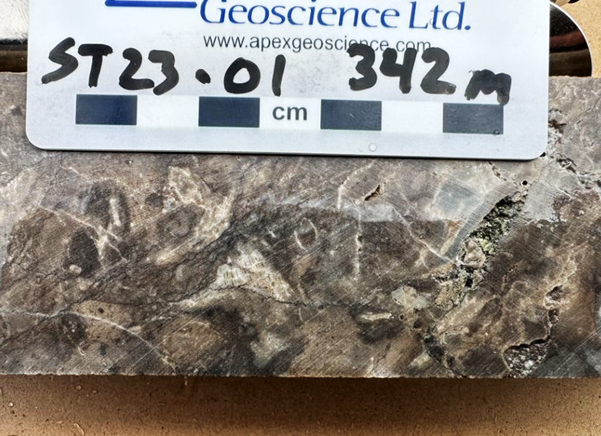
DRILL HOLE ST23-02 DETAILS
Drill hole ST23-02 was drilled to a downhole depth of 602m and intersected a continuous 37m thick zone of visual copper mineralization from 333m downhole (Figure 7).
The mineralized interval is variably brecciated and fractured with chalcocite as the dominant copper sulfide mineral. The lower section of the interval contains very strong mineralization with 1-5% visual sulfide and localized breccias containing up to 30% chalcocite. Rare native copper and sphalerite (zinc sulfide) along with pyrite are present within the lower part of the mineralized sequence.
The copper mineralization is hosted within bioturbated mudstones within a broader interval of fossiliferous carbonates. The geology and mineralization are very similar to drill holes ST23-01 and ST22-10 and located at a similar depth (Figure 7). Mineralization elsewhere at Storm is zoned (chalcocite - chalcopyrite - pyrite - sphalerite/galena), so the presence of chalcocite suggests that drill hole ST23-02 is potentially vectoring to the higher-grade portions of the copper system.
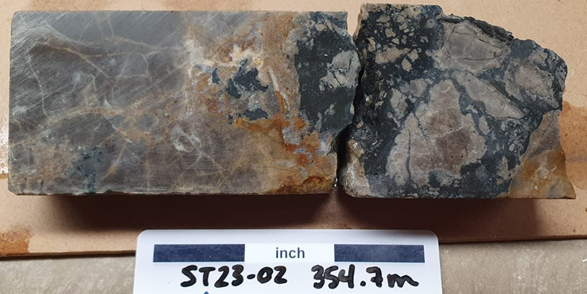
Hole ID | From (m) | To (m) | Min | Description |
ST23-02 | 0.0 | 47.5 | Cape Storm Formation | |
47.5 | 58 | Allen Bay Formation | ||
58 | 62 | cp, py | fine disseminated along fractures py/cp (0.1%) | |
62 | 78.5 | Dolomudstone | ||
78.5 | 109 | py | Trace and blebby pyrite (0.1%) | |
109 | 239 | Dolomudstone with rare pyrite | ||
239 | 239.5 | sph | Fault breccia with clay and anomalous zinc | |
239.5 | 310 | Dolomudstone | ||
310 | 322 | Crystalline dolowackestone | ||
322 | 333 | Coral floatstone with stromatolite | ||
333 | 353 | cc | Fractured/brecciated with trace cc (0.1%) | |
353 | 356 | cc, py | Breccia fill cc (1-2%) with thicker bands (30%) | |
356 | 357 | cc | Silty band with cc (2-5%), thicker bands (20%) | |
357 | 360 | cc, py | Breccia fill cc (1-2%) with thicker bands (30%) | |
360 | 370 | Cu, sph | Local floatstone with native Cu (1%) | |
370 | 381 | Muddy laminated limestone | ||
381 | 441 | Dolomudstone with occasional floatstone | ||
441 | 455 | py | Massive dolomudstone with py (0.1%) filled vugs | |
455 | 602 | Dolomudstone with occasional floatstone |
Table 3: Summary geological log for drill hole ST23-02. Mineralization key: cc = chalcocite, cp = chalcopyrite, br = bornite, py = pyrite, Cu = native copper, ct = cuprite, ml = malachite, sph = sphalerite, ga = galena. (5%) = visual estimation of sulfide content.
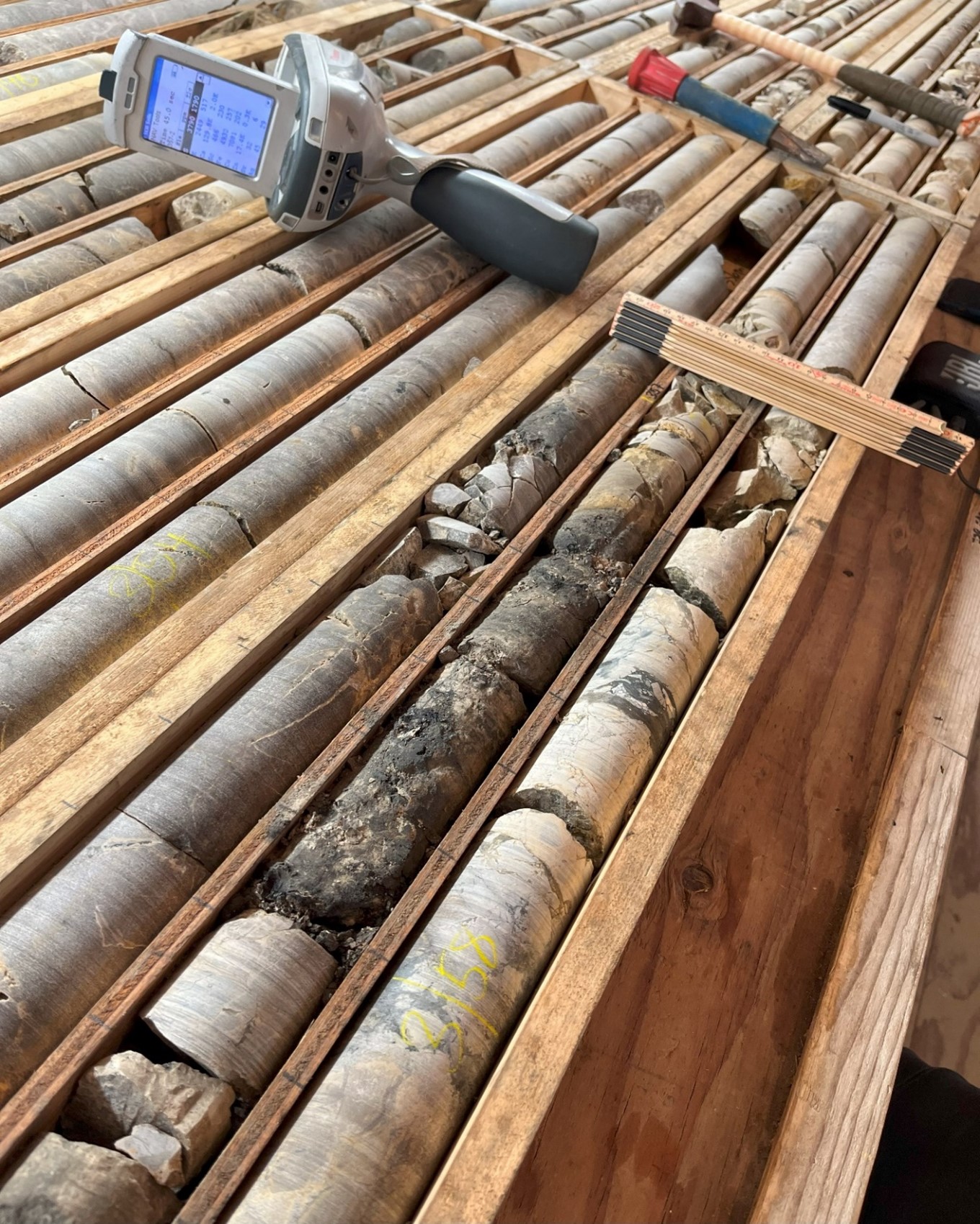
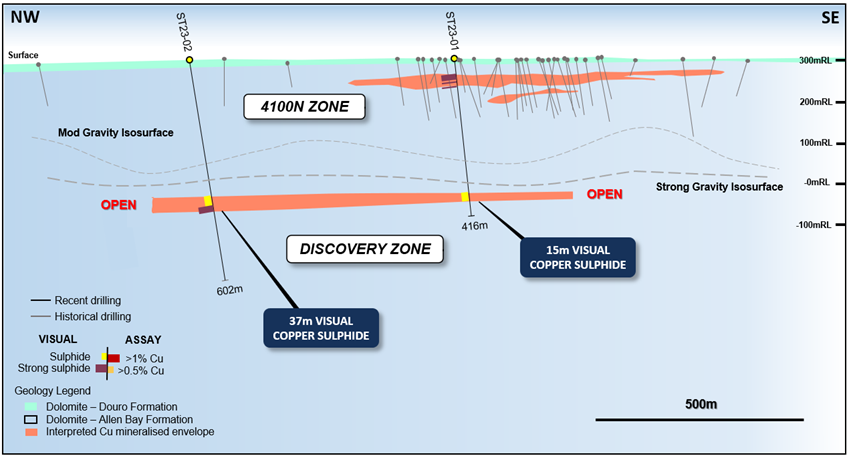


Figure 8: Map of the Storm and Tornado/Blizzard areas showing the ground gravity survey data over Storm (2023 survey) and Tornado/Blizzard (2015 survey), overlaying the property-scale airborne gravity gradiometry survey data (2017 Falcon Survey).
EXTENSIVE COPPER SYSTEM AT STORM
The copper mineralization and geology within drill holes ST23-01, ST23-02 and ST22-10 are highly similar and suggest that the stratigraphy of the mineralized system is laterally very extensive. The geometry of the host package is interpreted to be relatively flat-lying and predictable, with thick sequences of altered sediments comprised of dolomudstone and carbonate rocks.
The geology of the mineraliz

